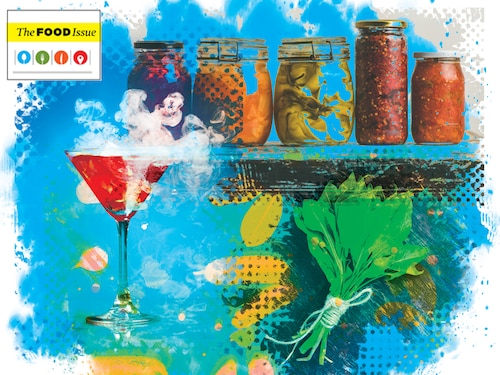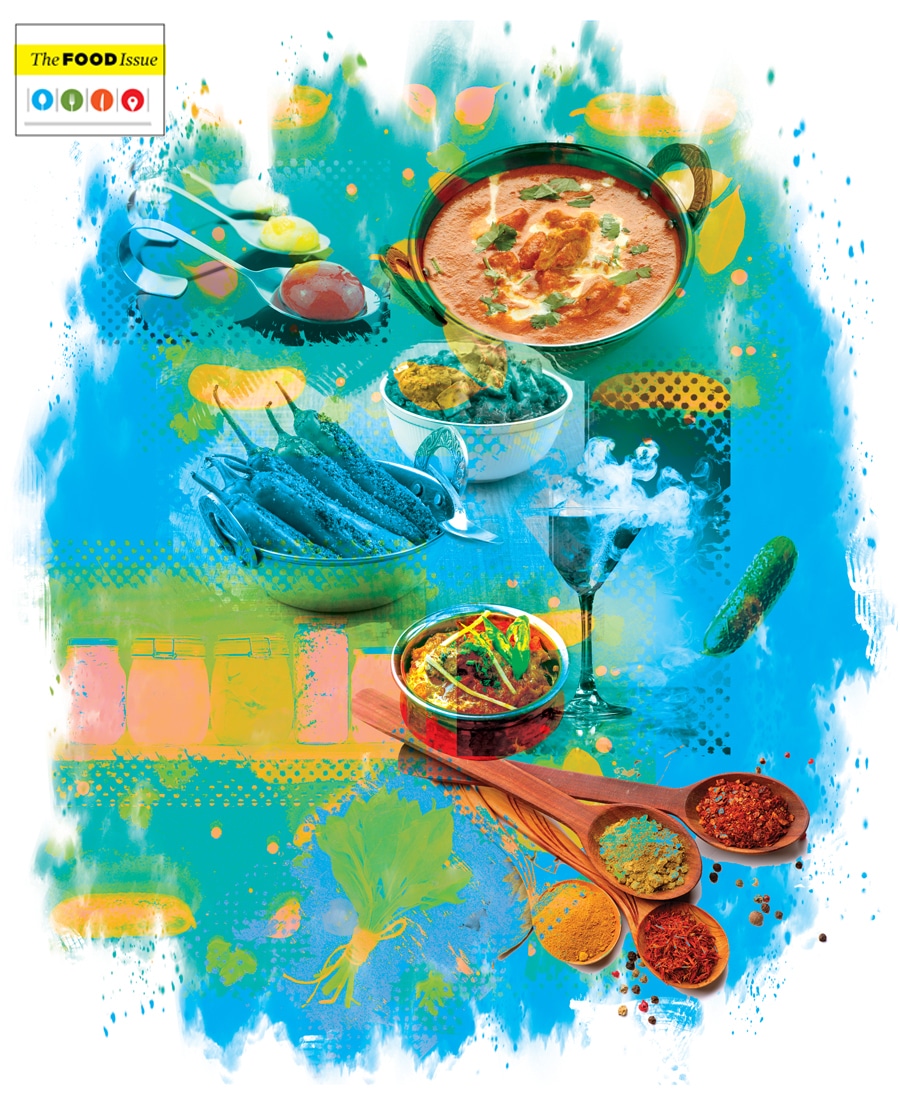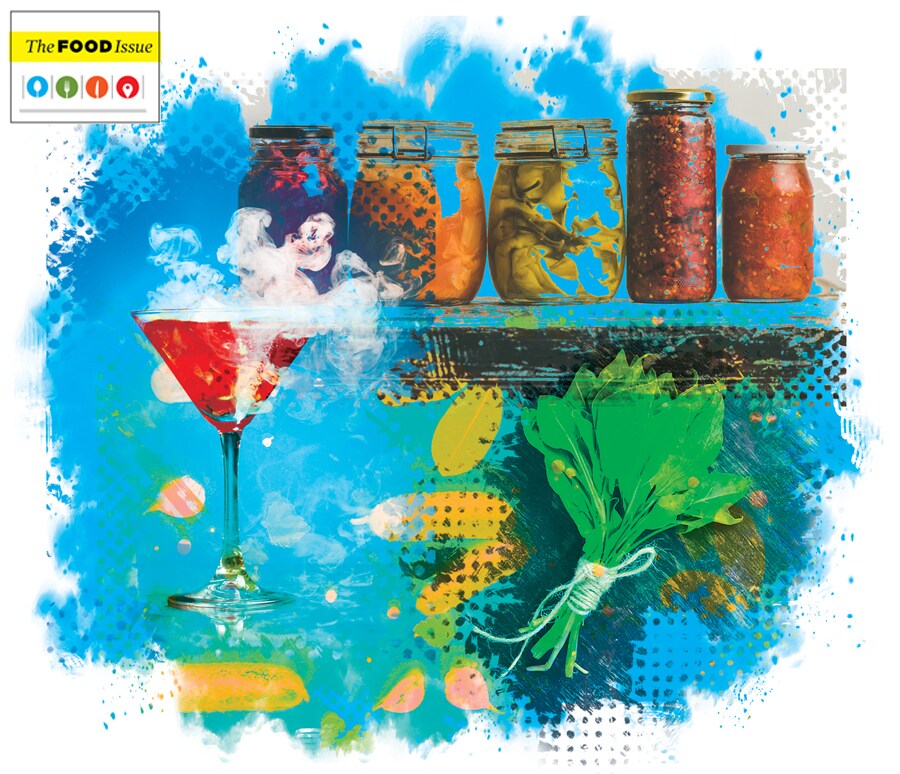Modern Indian food: Innovative or desperate?
With the rise—and fall—of gimmickry and imitation in modern Indian cuisine, chefs are digging deeper into India's hinterland to innovate and survive diner fatigue


 Illustrations: Chaitanya Dinesh Surpur
Illustrations: Chaitanya Dinesh Surpur
At Indian Accent, the modern Indian restaurant he helms in Delhi, New York and London, chef Manish Mehrotra gives the humble Indian flatbread a nifty makeover. By stuffing pillowy quarter-sized naans with molten blue cheese and pairing kulchas with oddball ingredients—smoked bacon, wild mushroom, among others—the 45-year-old reinvents stuffed parathas that are a staple of North Indian kitchens.
As open as he is to experimenting, Mehrotra was left bristling at a Delhi restaurant that served him bacon and blue cheese kulcha—a cross between two signature bread varieties at his own restaurant. “The chef doesn’t realise that blue cheese and bacon don’t get along well both have strong flavours that clash when put together. It’s experiments like these that give modern twists a bad name,” says the chef, whose restaurant is the highest-ranked (60) Indian eatery in Best Restaurants list of 2019.
Mehrotra—widely recognised as the torchbearer of the progressive Indian movement—is not alone in his anguish over copycats and wannabes. Saransh Goila, founder of Goila Butter Chicken, recalls that before he launched his venture three years ago, he was approached by a number of restaurateurs looking to do modern Indian—“whatever Gaggan Anand does”. “They understood only the theatrics of Gaggan, but not his food philosophy,” says Goila. That the Bangkok-based Anand’s ‘yogurt explosion’ is in essence a flavour-packed dahi chaat was lost in fancy claptraps over his molecular techniques. Instead, F&B entrepreneurs became busy putting together dishes that were hashtag-worthy not in their flavours but in form—foams, spheres, smoke, what have you.
Battle-hardened chefs apart, more and more diners, too, are calling out outlandish flavours that are passed off as innovative Indian food. Lazy hacks like a lobster vada pav or a dal makhni pizza aren’t cutting ice anymore as isn’t unimaginative food being served in a beaker, syringe or shabby chic stainless steel crockery.
Salonee Sanghvi, a wealth manager and travel blogger, still squirms at the thought of a bhel served with smoke or a sweet kaali dal served at a now-shuttered restaurant. “Many restaurants have been playing with gimmicks and presentation so much that they seem to have forgotten to focus on flavours. When there’s so much show, the food itself ends up being disappointing. Restaurants need to understand that people are going to come for gimmicks only once, not again and again,” says Sanghvi.
The pursuit of culinary stunts almost turned fatal in 2017 when a liquid nitrogen-laced cocktail burnt a hole in the stomach of a 30-year-old man in Gurugram. An emergency surgery saved his life, but it led Haryana to ban the use of the chemical in food. Fuming at the baby being thrown out with the bath water, Anand had told Forbes India in an earlier interview: “Chefs in India don’t understand what molecular is. [They] don’t want to understand the science of molecular gastronomy. Frying oil needs to be at a specific temperature... liquid nitrogen has to be used to attain certain textures. In India, there’s little awareness.”
Underdone and undone
Indian cuisine took on its progressive avatar in the mid-noughties to break away from an identity defined by generic curries or the ubiquitous butter chicken and tikka masala. As the demography was shedding its stodgy outlook, so was food. Black dal with a swirl of cream and the bread basket smeared with butter or ghee was a legacy that a group of chefs didn’t want to take forward instead, they were looking to grab a seat at the global table with an erudite understanding of flavours and use of cutting-edge techniques.
“It’s always been a problem that Indian food, like Italian food, is a collection of recipes. French food, on the other hand, is a collection of techniques and it’s much easier to invent new dishes. In Indian food, for instance, there’s supposed to be only one way of making, say, a rogan josh. The chefs who took on Indian flavours and said we can put them into other things were first Mehrotra, and after that, Anand. Pretty much everybody else has followed in their footsteps,” says Vir Sanghvi, veteran journalist and food writer.
The Mehrotras and Anands, though, did not go about reinventing the wheel. Instead they dug deep into culinary traditions, pulled them out of regional households, and touched up their worn-out novelty.
Mehrotra’s cheeni-malai toast on the menu of his restaurant Comorin in Gurugram is a throwback to the sugar-coated toasts that kids lick clean at home. Anand’s modernist ghewar, baked and topped with cheese, will take the palate to the streets of Rajasthan. And the sol kadi ceviche prepared by Thomas Zacharias, chef-partner of Mumbai’s The Bombay Canteen (named the restaurant of the year in 2018 by Conde Nast Traveller’s top restaurant awards), is a tribute to the Konkani drink in which the fish is marinated.
Meanwhile, as the middle-class began to see higher disposable incomes, eating out became a national pastime. The 2019 Food Services Report by the National Restaurant Association of India pegs India’s food services market at ₹423,865 crore in 2018-19 and expects it to grow at a CAGR of 9 percent. Along with this has come an exponential evolution of tastes, a far cry from two decades ago, when chef Sanjeev Kapoor opened his restaurant Khazana in Dubai. “Our menu was pathbreaking, even ahead of what molecular gastronomy does today. But people used to come and say, ‘You don’t have butter chicken, you don’t have bhindi masala’, and the owners got us to change the menu in two weeks,” says Kapoor. “Today, diners are willing to experiment. However, the cardinal rule is that you experiment with form, not flavour. So diners will take a chutney foam and a yogurt bubble, but together, it should all taste like the chaat they are familiar with.”
Once accolades started to pour in for modern Indian cuisine—The Bombay Canteen, for instance, received a vote of confidence on Twitter from actor Rishi Kapoor months after it opened in 2015—aspiring restaurateurs zeroed in on it as a hit formula to tap the large customer base. And that’s where the plot was lost. A raft of upstart me-toos mushroomed with zero knowledge of flavour profiles—think Maggi in makhni sauce, or sambar foams—and the trend began to unravel. To a diner, modern Indian food began to represent gimmicks sans flavours: A deconstructed vada pav that has neither the style nor the substance, or a coriander foam that a Mumbai eatery garnishes many of its dishes with, even when it can’t be tasted.
Subhasree Basu, co-founder of Greedy Foods, a Mumbai-based cloud kitchen, and an inveterate foodie, says, “The space has turned into a stylist’s game, instead of the chef’s. They are focusing more on embellishments and presentation rather than core flavours. If you have morels on your menu, you can’t use them to just make a dish look rich. They have to be your centrepiece, else it’s just wastage.”
Recipe for success
Flavour is something that most modernist chefs and restaurateurs who’ve cracked the code love to repeat. It’s the thin line between the bizarre and the bold and the hook that’ll bring back diners to modern Indian food. To paraphrase a sports adage, ‘form is temporary, flavour is permanent’.
Zorawar Kalra, proprietor of Massive Restaurants that owns brands like Masala Library, Farzi Cafe and Pa Pa Ya and has expanded across seven countries in as many years, was among the earliest adopters of molecular gastronomy in India but won’t trade flavours for technique. At his Farzi Cafe, a modern Indian bistro, Kalra’s team has been plating a raj kachori with a foam of tamarind chutney not because it looks fancy but because it delivers only a fraction of the calories that a regular chutney would have without compromising on its flavour. Bottomline: You can’t be creative without being authentic.
At Comorin, Mehrotra serves the Kanyakumari crab with crispy idiyappam and not, say garlic naan, “because it’s not true to the region”. Zacharias of The Bombay Canteen embarks on a trip every three months to discover unknown flavours in remote corners of the country and the world. Once he returns to his workstation in Mumbai, he begins by recreating the original dish before innovating on individual elements. “The idea is to exercise restraint and not alter the DNA of the dish,” he says. “And that thin line between restraint and innovation is sometimes the hardest to straddle.”
Modernising flavours for the millennial palate is what got Goila to launch and scale up a food venture riveted on butter chicken, arguably India’s biggest food cliche. Young, health-conscious diners avoid greasy food, so Goila altered his tomato-dairy ratio from 50:50 to 80:20. “My challenge was to make a dish tasty enough without a lot of butter and cream. I did it through nailing the flavour and sourcing quality ingredients—kasuri methi from old Delhi and cashews from Goa,” says Goila, who went from a takeaway-only service in 2016 to five outlets in three years.
Goila’s success with butter chicken has thrown open the debate on whether modern can be decoupled from traditional or whether the route to the former is through the latter. Kapoor, who became a household name in the early 1990s with his TV show Khana Khazana, stirs the pot even further by saying modern or progressive Indian cuisine are terms coined by writers in recent times to define a trend that has existed in the industry for decades.
“In college, we would playfully add cocoa to make chocolate gulab jamun. My first menu about 25 years ago had golgappa with prawns, and I served it with solkadi. I never called it modern Indian, I was just playing around. Chefs love to play with techniques, back then and even now,” he says. “Only now, it’s the way the food is branded, because people expect us to.”
At the far end of the spectrum from Kapoor stands Kalra with his team of chefs that serves up levitating desserts, sushi burgers and cocktails in a lightbulb. Despite seemingly disparate forms of food that they specialise in, Kalra seems to echo Kapoor when he says innovation is not restricted to science. “My dad [the late food writer-turned-consultant] Jiggs Kalra invented the tandoori salmon and there was nothing molecular about it, yet it was one of the most innovative dishes of his time,” he says. All Senior Kalra, an entrenched traditionalist, did was to use quality Scottish or Norwegian salmon, marinate it in traditional Indian spices, incorporate novelty by adding orange juice and red wine, and soon he had heads of states swooning over its flavours.
In fact, Kalra now claims to be entering into a post-molecular phase that, on one hand, uses equipment at the cutting edge of innovation—tonic homogenisers, rotary evaporators, etc—and, on the other, traditional techniques like pickling. At Mumbai’s Masala Library, he offers kheema with bitter gourd in which the vegetable almost turns sweet after a fortnight of pickling. Soon, he’s looking to open a single-outlet restaurant in Delhi that’ll pay homage to his late father’s extensive research on food and his traditionalist roots. “There will be no molecular there. The modern world is the juxtaposition of the old and the new and that’s where cuisine is headed in future,” he says.
Zacharias takes this marriage even further by exploring traditional, local produce that hasn’t made it to the menus of many Indian restaurants yet. In the last four years at The Bombay Canteen he’s used around 120 vegetables in his kitchen, all of which are indigenous and seasonal. The 33-year-old is loathe to using anything imported, which means he’s shut the doors on regulars like avocado, olive oil, broccoli, lettuce or asparagus. He took two years to put together an Indian equivalent of the beetroot and goat’s cheese salad, replacing the cheese with the Parsi topli paneer and the salad greens with young amaranth leaves.
“The next level of innovation will come from exploring the unexplored, from showcasing food that’s either misrepresented or underrepresented. Like food from the Northeast. It’s about breaking stereotypes even within regions. Rajasthan isn’t just about dal-baati-churma, or Kerala about appam and stew,” says Zacharias.
Will they swing the pendulum away from rising diner fatigue? We’ll wait for the verdict once the next course is served.
First Published: Sep 04, 2019, 13:42
Subscribe Now